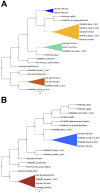Middle East respiratory syndrome coronavirus infection in dromedary camels in Saudi Arabia
- PMID: 24570370
- PMCID: PMC3940034
- DOI: 10.1128/mBio.00884-14
Middle East respiratory syndrome coronavirus infection in dromedary camels in Saudi Arabia
Erratum in
- MBio. 2014;5(2):e01002-14. Burbelo, Peter D [added]
Abstract
The Middle East respiratory syndrome (MERS) is proposed to be a zoonotic disease; however, the reservoir and mechanism for transmission of the causative agent, the MERS coronavirus, are unknown. Dromedary camels have been implicated through reports that some victims have been exposed to camels, camels in areas where the disease has emerged have antibodies to the virus, and viral sequences have been recovered from camels in association with outbreaks of the disease among humans. Nonetheless, whether camels mediate transmission to humans is unresolved. Here we provide evidence from a geographic and temporal survey of camels in the Kingdom of Saudi Arabia that MERS coronaviruses have been circulating in camels since at least 1992, are distributed countrywide, and can be phylogenetically classified into clades that correlate with outbreaks of the disease among humans. We found no evidence of infection in domestic sheep or domestic goats. IMPORTANCE This study was undertaken to determine the historical and current prevalence of Middle East respiratory syndrome (MERS) coronavirus infection in dromedary camels and other livestock in the Kingdom of Saudi Arabia, where the index case and the majority of cases of MERS have been reported.
Figures



Comment in
-
Concerns about misinterpretation of recent scientific data implicating dromedary camels in epidemiology of Middle East respiratory syndrome (MERS).mBio. 2014 Jul 8;5(4):e01430-14. doi: 10.1128/mBio.01430-14. mBio. 2014. PMID: 25006231 Free PMC article. No abstract available.
-
Reply to "Concerns about misinterpretation of recent scientific data implicating dromedary camels in epidemiology of Middle East respiratory syndrome (MERS)".mBio. 2014 Jul 8;5(4):e01482-14. doi: 10.1128/mBio.01482-14. mBio. 2014. PMID: 25006235 Free PMC article. No abstract available.
-
The origins of viruses: discovery takes time, international resources, and cooperation.Lancet. 2021 Oct 16;398(10309):1401-1402. doi: 10.1016/S0140-6736(21)02180-2. Epub 2021 Sep 30. Lancet. 2021. PMID: 34600605 Free PMC article. No abstract available.
Similar articles
-
Cross-sectional study of MERS-CoV-specific RNA and antibodies in animals that have had contact with MERS patients in Saudi Arabia.J Infect Public Health. 2018 May-Jun;11(3):331-338. doi: 10.1016/j.jiph.2017.09.022. Epub 2017 Oct 6. J Infect Public Health. 2018. PMID: 28993171 Free PMC article.
-
Cross-sectional surveillance of Middle East respiratory syndrome coronavirus (MERS-CoV) in dromedary camels and other mammals in Egypt, August 2015 to January 2016.Euro Surveill. 2017 Mar 16;22(11):30487. doi: 10.2807/1560-7917.ES.2017.22.11.30487. Euro Surveill. 2017. PMID: 28333616 Free PMC article.
-
Middle East respiratory syndrome coronavirus quasispecies that include homologues of human isolates revealed through whole-genome analysis and virus cultured from dromedary camels in Saudi Arabia.mBio. 2014 Apr 29;5(3):e01146-14. doi: 10.1128/mBio.01146-14. mBio. 2014. PMID: 24781747 Free PMC article.
-
Middle East respiratory syndrome coronavirus antibody reactors among camels in Dubai, United Arab Emirates, in 2005.Transbound Emerg Dis. 2014 Apr;61(2):105-8. doi: 10.1111/tbed.12212. Epub 2014 Jan 24. Transbound Emerg Dis. 2014. PMID: 24456414 Free PMC article. Review.
-
Comparative analysis of the genome structure and organization of the Middle East respiratory syndrome coronavirus (MERS-CoV) 2012 to 2019 revealing evidence for virus strain barcoding, zoonotic transmission, and selection pressure.Rev Med Virol. 2021 Jan;31(1):1-12. doi: 10.1002/rmv.2150. Epub 2020 Aug 17. Rev Med Virol. 2021. PMID: 32803835 Free PMC article. Review.
Cited by
-
Towards a Comprehensive Definition of Pandemics and Strategies for Prevention: A Historical Review and Future Perspectives.Microorganisms. 2024 Aug 30;12(9):1802. doi: 10.3390/microorganisms12091802. Microorganisms. 2024. PMID: 39338476 Free PMC article. Review.
-
ACE2 from Pipistrellus abramus bats is a receptor for HKU5 coronaviruses.bioRxiv [Preprint]. 2024 Aug 16:2024.03.13.584892. doi: 10.1101/2024.03.13.584892. bioRxiv. 2024. PMID: 38559009 Free PMC article. Preprint.
-
SARS-CoV-2 vaccination in paediatric patients with epilepsy: experience of a tertiary center in Colombia.Rev Neurol. 2023 Jul 1;77(1):13-18. doi: 10.33588/rn.7701.2023127. Rev Neurol. 2023. PMID: 37365720 Free PMC article.
-
Versatile use of bat ACE2 for cellular entry by MERS-CoV-like viruses.Cell Host Microbe. 2023 Feb 8;31(2):161-163. doi: 10.1016/j.chom.2022.12.013. Cell Host Microbe. 2023. PMID: 36758513 Free PMC article.
-
A framework for measuring timeliness in the outbreak response path: lessons learned from the Middle East respiratory syndrome (MERS) epidemic, September 2012 to January 2019.Euro Surveill. 2022 Dec;27(48):2101064. doi: 10.2807/1560-7917.ES.2022.27.48.2101064. Euro Surveill. 2022. PMID: 36695460 Free PMC article.
References
-
- WHO 2013. Middle East respiratory syndrome coronavirus (MERS-CoV)—update. World Health Organization, Geneva, Switzerland: http://www.who.int/csr/don/2013_12_27/en/index.html?utm_source=twitterfe...
-
- Assiri A, McGeer A, Perl TM, Price CS, Al Rabeeah AA, Cummings DA, Alabdullatif ZN, Assad M, Almulhim A, Makhdoom H, Madani H, Alhakeem R, Al-Tawfiq JA, Cotten M, Watson SJ, Kellam P, Zumla AI, Memish ZA, Team KM-CI 2013. Hospital outbreak of Middle East respiratory syndrome coronavirus. N. Engl. J. Med. 369:407–416. 10.1056/NEJMoa1306742 - DOI - PMC - PubMed
Publication types
MeSH terms
Substances
Associated data
- Actions
- Actions
- Actions
- Actions
- Actions
- Actions
- Actions
- Actions
- Actions
- Actions
- Actions
- Actions
- Actions
- Actions
- Actions
- Actions
Grants and funding
LinkOut - more resources
Full Text Sources
Other Literature Sources
